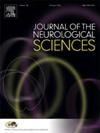Electroencephalography in patients with immune effector cell-associated neurotoxicity syndrome (ICANS)
IF 3.2
3区 医学
Q1 CLINICAL NEUROLOGY
引用次数: 0
Abstract
Background & objectives
Seizures are a recognized complication of immune effector cell-associated neurotoxicity syndrome (ICANS) from chimeric antigen receptor T cell therapy (CAR-T). Our objective was to characterize continuous (electroencephalogram) EEG data during ICANS to understand EEG patterns in the broader clinical context.
Methods
Clinical and EEG data was collected retrospectively from 2018 to 2023 in patients who underwent CAR-T for cancer and subsequently developed ICANS. Baseline cognitive status, brain MRI findings, and neurological involvement of tumor were noted. Infectious and metabolic status was documented.
Results
Twenty-nine patients met inclusion criteria. Those who underwent EEG during ICANS had higher grades of ICANS (p < 0.001). Clinical seizures were rare but correlated with increased mortality from ICANS (p = 0.008). Thirty-six 24-h EEG recordings were analyzed across 16 patients. No seizure activity was captured on any EEG. Diffuse slowing was found in 97.2 % of EEGs, with 19.4 % showing focal slowing in the frontal and/or temporal leads. Non-epileptic triphasic morphology occurred in 41.7 % of studies. After controlling for concurrent toxic-metabolic derangements, ICANS remained the only explanation in six cases.
Discussion
Clinical seizure events were rare and highly associated with death from ICANS. No persistent epileptiform activity was found on continuous EEGs in our cohort after initiation of antiepileptics with or without other immunotherapy for ICANS, suggesting that prolonged EEG may be of limited utility once electrographic seizures have been ruled out. Frequent triphasic waves were noted in ICANS alone and should not exclude ICANS as the cause of encephalopathy after CAR-T.
免疫效应细胞相关神经毒性综合征(ICANS)患者的脑电图
背景,目的癫痫发作是嵌合抗原受体T细胞治疗(CAR-T)引起的免疫效应细胞相关神经毒性综合征(ICANS)的公认并发症。我们的目标是在ICANS期间描述连续(脑电图)脑电图数据,以了解更广泛临床背景下的脑电图模式。方法回顾性收集2018年至2023年接受CAR-T治疗癌症并随后发生ICANS的患者的临床和脑电图数据。记录基线认知状态、脑MRI结果和肿瘤的神经系统受累情况。记录感染和代谢状况。结果29例患者符合纳入标准。在ICANS期间接受脑电图的患者ICANS评分较高(p <;0.001)。临床发作罕见,但与ICANS死亡率增加相关(p = 0.008)。对16例患者的36个24小时脑电图记录进行分析。脑电图上没有捕捉到癫痫活动。97.2%的脑电图表现为弥漫性慢化,19.4%的脑电图表现为额叶和/或颞叶导联局灶性慢化。非癫痫性三相形态出现在41.7%的研究中。在控制了同时发生的毒性代谢紊乱后,ICANS仍然是6例中唯一的解释。临床发作事件罕见,且与ICANS的死亡高度相关。在我们的队列中,在抗癫痫药物联合或不联合其他免疫疗法治疗ICANS后,连续脑电图未发现持续的癫痫样活动,这表明一旦排除了电图癫痫发作,延长脑电图的效用可能有限。频繁的三相波仅在ICANS中被注意到,不应排除ICANS是CAR-T后脑病的原因。
本文章由计算机程序翻译,如有差异,请以英文原文为准。
求助全文
约1分钟内获得全文
求助全文
来源期刊

Journal of the Neurological Sciences
医学-临床神经学
CiteScore
7.60
自引率
2.30%
发文量
313
审稿时长
22 days
期刊介绍:
The Journal of the Neurological Sciences provides a medium for the prompt publication of original articles in neurology and neuroscience from around the world. JNS places special emphasis on articles that: 1) provide guidance to clinicians around the world (Best Practices, Global Neurology); 2) report cutting-edge science related to neurology (Basic and Translational Sciences); 3) educate readers about relevant and practical clinical outcomes in neurology (Outcomes Research); and 4) summarize or editorialize the current state of the literature (Reviews, Commentaries, and Editorials).
JNS accepts most types of manuscripts for consideration including original research papers, short communications, reviews, book reviews, letters to the Editor, opinions and editorials. Topics considered will be from neurology-related fields that are of interest to practicing physicians around the world. Examples include neuromuscular diseases, demyelination, atrophies, dementia, neoplasms, infections, epilepsies, disturbances of consciousness, stroke and cerebral circulation, growth and development, plasticity and intermediary metabolism.
 求助内容:
求助内容: 应助结果提醒方式:
应助结果提醒方式:


